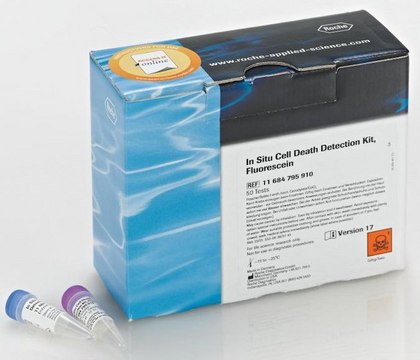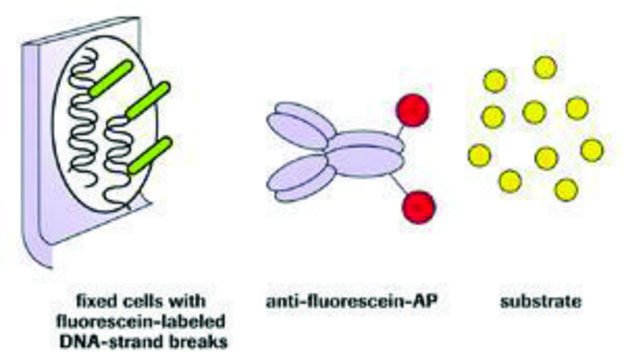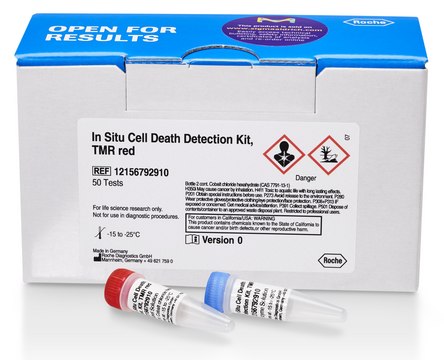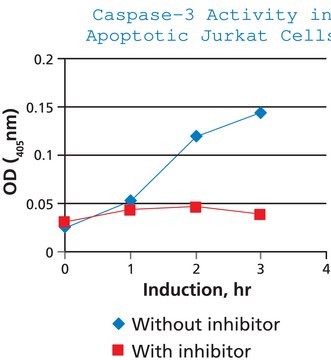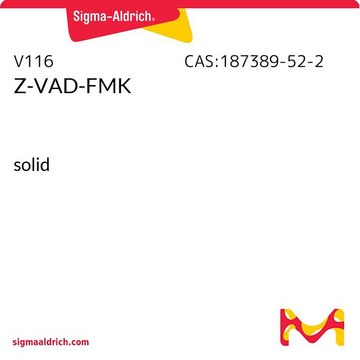11835246001
Roche
Apoptotic DNA-Ladder Kit
Synonym(s):
DNA ladder
Sign Into View Organizational & Contract Pricing
All Photos(1)
About This Item
UNSPSC Code:
41116133
Recommended Products
usage
sufficient for ≤20 tests
manufacturer/tradename
Roche
storage temp.
20-25°C
General description
This kit provides a way to isolate apoptotic DNA fragments for DNA ladder analysis. The purification method used is much faster than other DNA purification methods (e.g., phenol/chloroform extraction, DNA precipitation). Purified DNA can be mixed directly with gel loading buffer and analyzed on an agarose gel.
The study of cell death involves characterizing mortality as apoptotic or necrotic. Apoptosis can be characterized by:
Similarly, necrosis (or physiological cell death) is characterized by
As these differences indicate, the classification of cell death can be accomplished through observing cell morphology, or less subjectively, by analyzing genomic DNA. Resolving the DNA on a gel provides a quick and documentable form of data to differentiate between apoptosis and necrosis.
The study of cell death involves characterizing mortality as apoptotic or necrotic. Apoptosis can be characterized by:
- Prelytic, non-random fragmentation of DNA (“ladder” pattern after agarose-gel electrophoresis)1
- Formation of membrane-bound vesicles (or “apoptotic bodies”)
- Cell shrinkage due to a concentration of cytoplasm
Similarly, necrosis (or physiological cell death) is characterized by
- Random digestion of DNA (DNA smear after agarose-gel electrophoresis)
- Swollen organelles and cells, resulting from loss of membrane integrity and cell lysis
- Postlytic DNA fragmentation
As these differences indicate, the classification of cell death can be accomplished through observing cell morphology, or less subjectively, by analyzing genomic DNA. Resolving the DNA on a gel provides a quick and documentable form of data to differentiate between apoptosis and necrosis.
Specificity
Only nucleic acid will bind to the glass fiber filters under the conditions outlined in the kit. Salts, proteins, and other cellular components do not bind.
Application
The Apoptotic DNA-Ladder Kit provides rapid isolation of DNA, which can be analyzed and characterized by gel electrophoresis for the determination of apoptotic cell death.
Packaging
1 kit containing 6 components.
Principle
Blood or cell lysis is accomplished by incubating the sample with the special Binding/Lysis Buffer. The sample is centrifuged through a column that contains glass fiber fleece. In the Binding/Lysis Buffer, nucleic acids quickly and preferentially bind to the surface of the glass fibers. The Washing Buffer rinses away salts, proteins, and other cellular debris. DNA is subsequently collected via a centrifugation step with elution buffer.
Preparation Note
Working solution: Note: Before starting a purification reaction warm the Elution Buffer to 70 °C, all other reagents should be at 15 to 25 °C.
Preparation of Working Solutions
EDTA solution (0.5 M)
Dissolve 18.6 g EDTA in 80 ml double dist. water and stir. Adjust pH 8.0 ± 0.1 with 1 M NaOH. EDTA solubilizes at alkaline pH only. After solubilization fill up to 100 ml with double dist. water.
TBE-Buffer
Dissolve 5.4 g Tris, 2.8 g Boric acid in 800 ml double dist. water and add 2 ml
of 0.5 M EDTA solution . Stir until dissolved, final pH 8.0 ± 0.1. Fill up to 1 liter with double dist. water.
Ethidium bromide stock solution
Dissolve 50 mg ethidium bromide in 5 ml double dist. water (ethidium bromide is a mutagen and potential carcinogen; gloves should be worn and care should be taken when handling ethidium bromide solutions).
Alternatively SYBR Green I Nucleic Acid Gel Stain can be used instead of Ethidium bromide.
Loading Buffer (10x)
Dissolve 0.1 g sodium dodecyl sulfate, 25 mg Bromophenol Blue in 7 ml double dist. water and add 3 ml glycerol
Storage conditions (working solution): The positive control can be used for 14 days after preparation, when storing the isolated control DNA at -15 to -25 °C.
Preparation of Working Solutions
- Add 80 ml ethanol, analysis grade, to Washing Buffer
- Dissolve Positive Control (violet cap) in 400 μl Binding/Lysis Buffer and mix immediately.
- Incubate for 10 minutes at 15 to 25 °C.
EDTA solution (0.5 M)
Dissolve 18.6 g EDTA in 80 ml double dist. water and stir. Adjust pH 8.0 ± 0.1 with 1 M NaOH. EDTA solubilizes at alkaline pH only. After solubilization fill up to 100 ml with double dist. water.
TBE-Buffer
Dissolve 5.4 g Tris, 2.8 g Boric acid in 800 ml double dist. water and add 2 ml
of 0.5 M EDTA solution . Stir until dissolved, final pH 8.0 ± 0.1. Fill up to 1 liter with double dist. water.
Ethidium bromide stock solution
Dissolve 50 mg ethidium bromide in 5 ml double dist. water (ethidium bromide is a mutagen and potential carcinogen; gloves should be worn and care should be taken when handling ethidium bromide solutions).
Alternatively SYBR Green I Nucleic Acid Gel Stain can be used instead of Ethidium bromide.
Loading Buffer (10x)
Dissolve 0.1 g sodium dodecyl sulfate, 25 mg Bromophenol Blue in 7 ml double dist. water and add 3 ml glycerol
Storage conditions (working solution): The positive control can be used for 14 days after preparation, when storing the isolated control DNA at -15 to -25 °C.
Other Notes
For life science research only. Not for use in diagnostic procedures.
Legal Information
NOTICE TO PURCHASER: This is a product licensed under patents owned by Qiagen.
Kit Components Only
Product No.
Description
- Binding/Lysis Buffer
- Washing Buffer
- Elution Buffer
- Polypropylene Tubes, contain two layers of glass fiber fleece and can hold up to 700 μl sample volume
- Polypropylene Collection Tubes
- Control Apoptotic U937 Cells, lyophilized
Signal Word
Danger
Hazard Statements
Precautionary Statements
Hazard Classifications
Acute Tox. 4 Oral - Aquatic Chronic 3 - Eye Dam. 1 - Skin Irrit. 2
Storage Class Code
12 - Non Combustible Liquids
WGK
WGK 2
Flash Point(F)
does not flash
Flash Point(C)
does not flash
Regulatory Information
高风险级别生物产品--病毒,疫苗等
Choose from one of the most recent versions:
Already Own This Product?
Find documentation for the products that you have recently purchased in the Document Library.
Shengfu Piao et al.
Autophagy, 13(12), 2056-2071 (2017-10-06)
Lysosomal autophagy inhibitors (LAI) such as hydroxychloroquine (HCQ) have significant activity in a subset of cancer cell lines. LAIs are being evaluated in cancer clinical trials, but genetic determinants of sensitivity to LAIs are unknown, making it difficult to predict
Edwin Chang et al.
Cell death discovery, 4, 113-113 (2018-12-12)
Glioblastoma is the most common yet most lethal of primary brain cancers with a one-year post-diagnosis survival rate of 65% and a five-year survival rate of barely 5%. Recently the U.S. Food and Drug Administration approved a novel fourth approach
Annegret Becker et al.
International journal of molecular sciences, 20(17) (2019-09-05)
Recently, we used a recombinant produced C-terminus (D194-F319) of the Clostridium perfringens enterotoxin (C-CPE) to functionalize gold nanoparticles (AuNPs) for a subsequent specific killing of claudin expressing tumor cells using the gold nanoparticle-mediated laser perforation (GNOME-LP) technique. For a future
Yuangang Wang et al.
International journal of molecular medicine, 32(5), 1077-1084 (2013-09-21)
Glioblastoma multiforme (GBM) is one of the most common malignant brain tumors. Saponin B, a novel compound isolated from the medicinal plant, Anemone taipaiensis, has been found to have a strong time- and dose-dependent cytostatic effect on human glioma cells
Mohd Javed Akhtar et al.
International journal of nanomedicine, 7, 845-857 (2012-03-07)
Zinc oxide nanoparticles (ZnO NPs) have received much attention for their implications in cancer therapy. It has been reported that ZnO NPs induce selective killing of cancer cells. However, the underlying molecular mechanisms behind the anticancer response of ZnO NPs
Articles
Cellular apoptosis assays to detect programmed cell death using Annexin V, Caspase and TUNEL DNA fragmentation assays.
Our team of scientists has experience in all areas of research including Life Science, Material Science, Chemical Synthesis, Chromatography, Analytical and many others.
Contact Technical Service